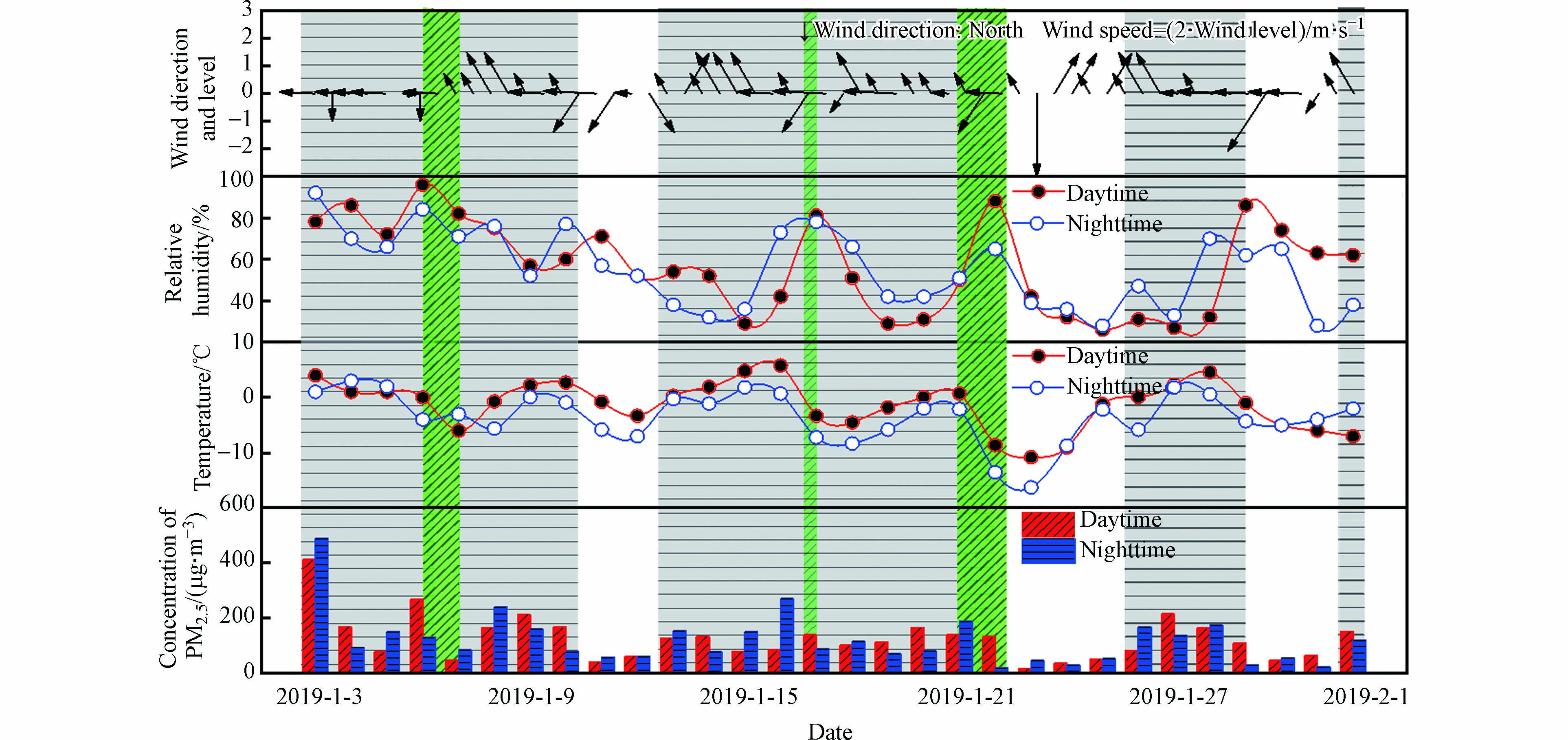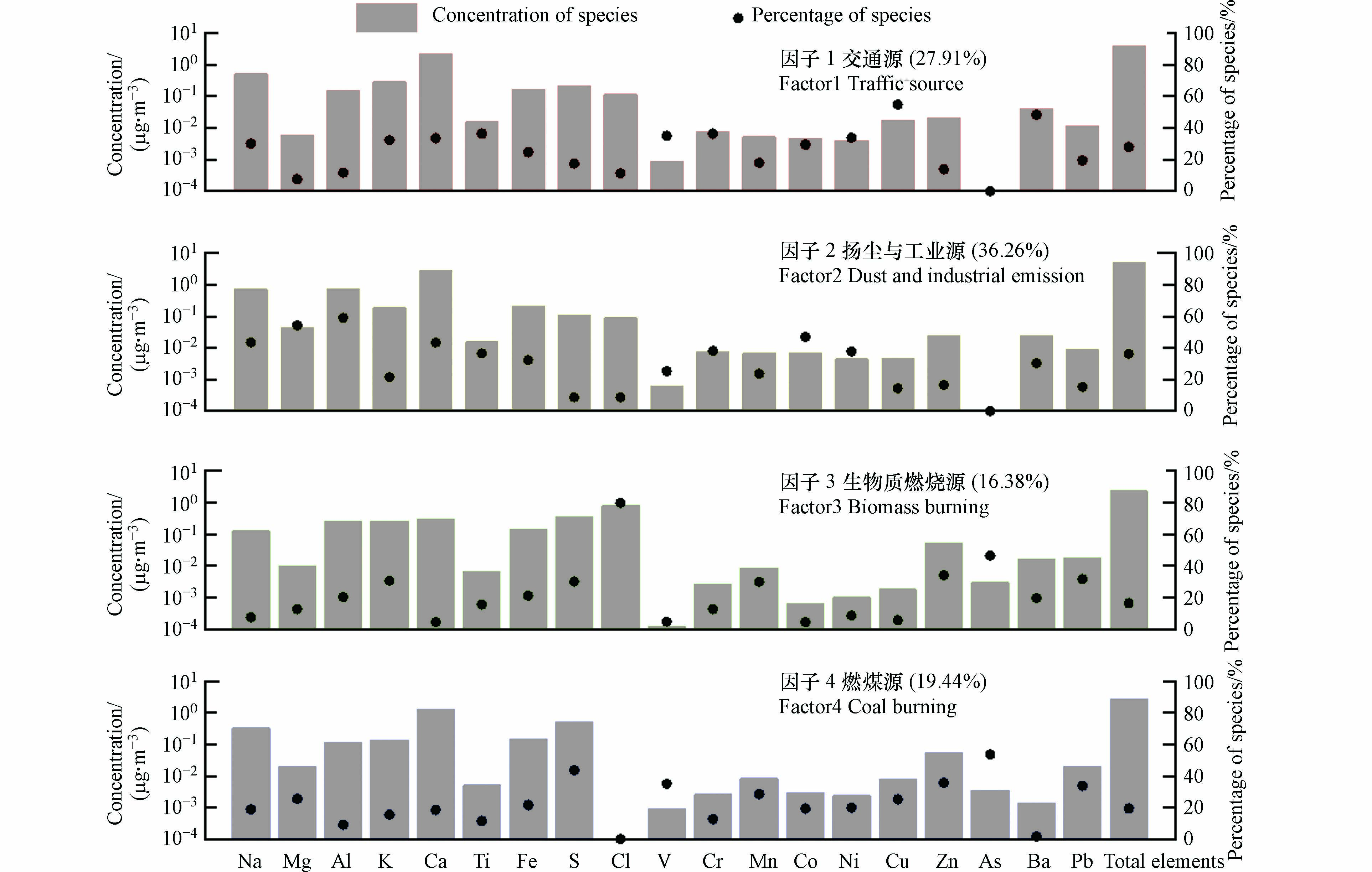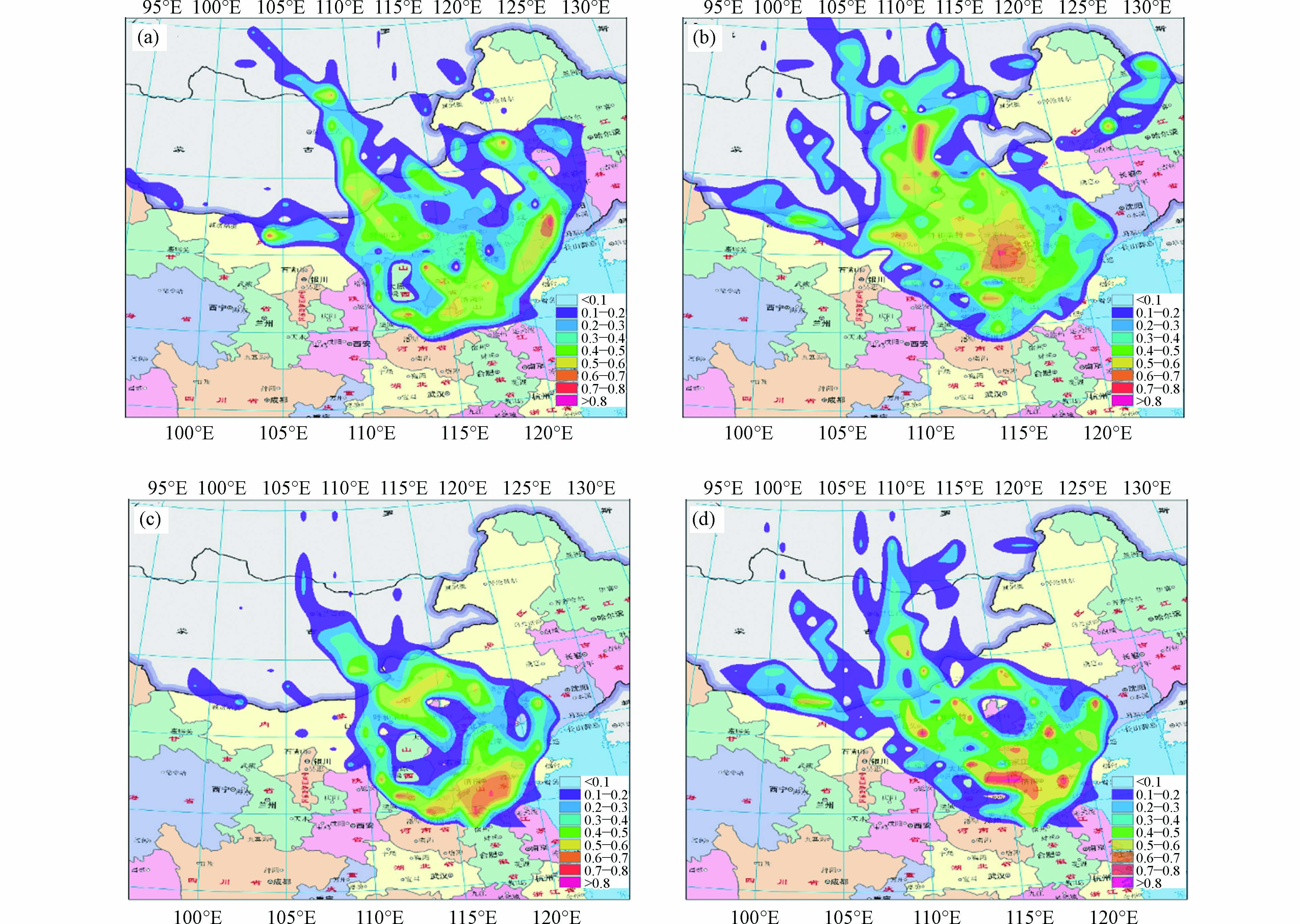-
PM2.5是影响城市大气环境和人类健康的主要污染物之一,并受到社会的广泛关注[1]。PM2.5中含有多种有害物质,对人体健康和生态环境具有很大危害,PM2.5中附着的一些重金属,具有降解难、反应活性高和毒性大等特点,可通过呼吸和摄食进入人体,是目前城市人群呼吸系统、心血管疾病和癌症发病的主要因素之一[2]。此外,一些重金属元素还可通过干湿沉降影响陆地和水生生态系统,从而破坏生态坏境[3]。有研究表明,PM2.5中元素的分布与其来源密切相关[4],研究PM2.5元素的浓度水平、分布特征、来源和传输途径对于深入理解其对人类健康和生态环境的影响具有重要科学意义。
近年来的大量研究表明,对PM2.5中的元素进行分析可识别重污染天气污染来源和对人类健康的影响。刘可可等[5]通过对比研究合肥市重污染期和清洁期颗粒物的元素组成差异,发现重污染天的Si、Al、Mg和Ca等地壳元素的含量明显降低,表明静稳天气下扬尘源对颗粒物的贡献明显减少,而S元素浓度明显增高,说明煤炭燃烧 是导致合肥市大气污染的主要原因。陈展乐等[6]分析了黄冈市重污染过程中PM2.5的元素组分,发现在静稳、高湿的天气条件下,煤炭燃烧、机动车尾气和工业排放是导致重污染天气形成的主要原因。Cui等[7]通过对新冠疫情时期京津之间乡村地区PM2.5元素组分的高时间分辨率分析,发现停工停产和交通管控措施导致了大气颗粒物微量元素的浓度下降。何瑞东等[8]通过对郑州市某生活区内的PM2.5中重金属进行健康评估,发现Mn对当地人群具有非致癌风险,Cd和As则具有致癌风险;Hassan等[9]通过对埃及吉萨市多次大气污染期间气溶胶化学特征的分析,发现沙尘暴期间该地PM2.5的质量浓度最高,且地壳元素与重金属的浓度均高于正常日;Mohsenibandpi等[10]对伊朗德黑兰细颗粒物中附着的重金属进行了健康风险评价,发现城区As的致癌风险高于Cd和Cr。以上研究为深入理解我国人口密集地区的中东部地区大气污染特征、来源及健康风险具有重要参考价值。
济南市地处华北地区,是我国重要的区域性经济中心,也是京津冀大气污染重要传输通道城市(“2+26”城市)之一。近年来,随着经济的不断发展,该市的大气环境污染依然十分严重,在2019年全国大气质量排名的168个城市中,济南市空气质量排在倒数第12名(https://www.aqistudy.cn/)。目前已有关于济南市大气颗粒物污染的研究,主要集中于水溶性无机离子、碳质组分和有机化合物等方面[11-14],而有关济南市PM2.5中元素的分布及来源,尤其是重金属污染特征和健康风险评价方面的研究尚不深入。因此,该研究旨在深入分析济南市冬季PM2.5中元素的污染特征和来源,尤其是重金属的污染特征及其健康风险,以期为济南市环境空气治理提供科学依据和制定居民的健康指南提供数据支撑。
-
采样点设在山东大学中心校区图书馆楼顶,距离地面约30 m,周围5 km范围内为住宅区、商业区、文教区和公园景点,地势较为开阔,周边无高大建筑物和明显污染源,济南市的工业企业基本分布在东部与北部的市郊(图1)。另外,采样点与济南市7个环境空气质量监测国控点周边的环境条件相似,基本能够反映济南市市区的大气污染状况。能客观反映济南市PM2.5的污染状况。该研究于2019年1月3日—2月1日利用PM2.5采样器(MiniVol TAS型5 L·min−1流量,47 mm石英滤膜)进行样品采集,采集时间为12 h (08:00—19.50,20:00—07:50),共获得60个环境样品和2个空白样品,采集后的样品使用铝箔纸封装后冷冻保存。使用灵敏度为0.1 μg的电子微量天平(瑞士,Mettle M3)对采样前后的滤膜进行称重以计算PM2.5的质量浓度。
-
采用能量色散X射线荧光光谱仪(ED-XRF, PANalytical)对PM2.5样品中的元素(包含Na、Mg、Al、K、Ca、Ti、Fe、S、Cl、V、Cr、Mn、Co、Ni、Cu、Zn、As、Ba和Pb)进行分析。元素受到X射线激发时会产生特征X射线,可根据激发后的能量峰的面积大小定量获得元素的浓度[5]。每组设置10个样品,重复测量其中1个作为平行样品以保证样品测试可靠性和精确性。共分析样品60个,平行样品6个,空白样品2个,并利用空白样品的数值扣除滤膜本底中无机元素对实验结果的干扰。
-
富集因子(EFs)是以土壤或地壳为参比介质,其比值常用来研究大气颗粒物元素富集程度[15]。富集因子的计算公式如下:
式中,C元素为该元素在大气颗粒物或土壤中的质量浓度(其在大气颗粒物和土壤中的单位分别为ng·m−3和mg·kg−1),C参比为所选定的参比元素的质量浓度(其在大气颗粒物和土壤中的单位分别为ng·m−3和mg·kg−1);(C元素/C参比)颗粒物为该研究的PM2.5环境样品中所测元素的平均浓度与参比元素平均浓度的比值;(C元素/C参比)土壤为土壤中该元素的平均浓度与参比元素平均浓度的比值;EFs为某元素在大气颗粒物中的富集因子,当C元素的EFs<1时,表明该元素没有富集,其来源全部来自于自然源;当C元素的1≤EFs<10时,属轻微富集,表明该元素主要来源于自然源,受人类活动的影响较小;当C元素的10≤EFs<100时,属中度富集,表明该元素主要来源于人类活动;当C元素的EFs>100,属与高度富集,表明其全部来源于人为源[15]。该研究中Ti元素在地球化学性质稳定,且质量分数变化较小,被选取作为参比元素。土壤中的各元素含量采用济南市土壤背景值[16]。
-
正定矩阵因子(positive matrix factorization, PMF)是一种基于多因子分析的受体模型,被广泛应用于大气颗粒物源解析中[17]。该研究选用美国环保署(environmental protection agency, EPA)开发的EPA PMF 5.0软件对PM2.5样品中元素进行来源解析,通过多次运行程序,试验不同因子参数和不确定性参数,寻找最小目标函数值,使残差矩阵值尽可能小,以确保模拟和观测结果具有较好相关性[6]。
-
潜在源贡献因子法(potential source contribution function, PSCF)是一种基于气流轨迹分析来识别污染源区的方法,该方法假设气团后向轨迹在某个网格中有滞留时间,那么该气团就会接收到来自这个区域排放的污染物,随后经过区域传输,对采样点的污染物浓度产生贡献[18],此外,为了提高PSCF数据质量,引入权重函数Wij来降低条件概率函数因样本总量n较小而产生误差的影响,即WPSCF=Wij×PSCFij。该研究利用此方法来确定影响济南市PM2.5元素的潜在污染源区,模型中涉及到的具体计算方式详见文献[18]。
-
为分析济南市冬季PM2.5中重金素元素对人体健康的影响,该研究采用EPA推荐的健康风险评估模型对经呼吸途径的PM2.5中重金属对人体健康造成的风险进行评价,包括致癌重金属元素(如Co、Ni、Cr与As)的致癌风险和对人体有其他危害的重金属元素(如V、Mn、Cu、Zn、Ba与Pb)的非致癌风险,计算公式为[8]:
式中,ADD为非致癌元素的日均剂量mg·(kg·d)−1;LADD表示致癌元素的日均剂量mg·(kg·d)−1;c为元素的质量浓度mg·m−3;IR代表呼吸频率m3·d−1;EF代表暴露频率d·a−1;ED代表暴露持续时间a;BW为体重kg;AT为平均暴露时间d。参数取值参考《中国人群暴露参数手册》[19]。
非致癌元素风险值HQ的计算公式为:
致癌元素风险值ILCR的计算公式为:
式中,RFD为非致癌元素的参考剂量mg·(kg·d)−1,V、Mn、Cu、Zn、Ba和Pb的取值[20]分别为7.0×10−3、1.4×10−5、4.0×10−2、3.0×10−1、2.0×10−1和3.5×10−3,当HQ≤1时,健康风险较小,当HQ>1时,存在非致癌风险。ILCR为终生增量致癌风险,表示由致癌元素引起的个人平均每年患癌的风险[20],SF为元素的致癌斜率因子(kg·d)·mg−1,Co、Ni、Cr和As的取值[20]分别为9.8、0.84、42和15。当ILCR<10−6时,表示该元素的致癌风险可以忽略;当ILCR>1×10−6,表示存在致癌风险。
-
济南市冬季PM2.5的质量浓度范围介于(16.0—487.0) μg·m−3之间,日均质量浓度为(122.2±86.8) μg·m−3,是我国环境空气质量标准(GB3095-2012)二级标准(75 μg·m−3)的1.6倍。观测期间,仅有7 d的PM2.5浓度未超过国家二级标准,占总采样期的23.3%,说明采样期间济南市大气环境长期处于污染状态。白天PM2.5的浓度(125.1±80.8) μg·m−3与夜间(119.4±93.7) μg·m−3相似 (t检验,P>0.05),表明观测期间济南市PM2.5质量浓度的昼夜变化不显著。
参照国家环境空气质量标准(GB 3095-2012),将采样期间分为污染期(≥75 μg·m−3)与清洁期(<75 μg·m−3)。污染期PM2.5的质量浓度(155.6±83.3) μg·m−3为清洁期(44.3±16.3) μg·m−3的3.5倍。由图2可知,观测期间共发生4次污染期,分别为1月3—10日、13—22日、26—29日和2月1日,PM2.5的平均质量浓度分别为192.7、129.3、149.6、135.5 μg·m−3。相较清洁期,污染期风速较低(<3.3 m·s−1),相对湿度相对较高(RH≥60%),风速较低有利于形成静稳天气,而高湿环境有利于二次颗粒物经非均相反应生成,进而加剧污染程度[10]。清洁期分别发生在1月11—12日、22—25日和30—31日,气象数据显示清洁期出现前均有冷空气过境(图2),风速加大(≥3.3 m·s−1),且相对湿度较低(RH<50%),表明有利的扩散条件是以上观测时段PM2.5降低的主要原因。
-
由表1可知,济南市冬季PM2.5中19种元素的总浓度为(14.3±3.9) μg·m−3,占PM2.5质量浓度的11.9%,浓度由高到低依次为Ca、Na、Al、S、Cl、K、Fe、Zn、Ba、Mg、Pb、Ti、Cu、Mn、Cr、Co、Ni、As和V。地壳元素(如Ca、Na、Mg、Al、K、Ti和Fe)的总浓度为(11.5±1.4) μg·m−3,占元素总浓度的80.4%。
济南市位于黄河下游南岸,该地区冬季低温干燥,盛行偏北风,多风的天气会将黄河沿岸的沙尘带向下风向的采样点附近[8],可造成大气颗粒物中地壳元素的含量升高。其中Ca的质量浓度最高,为(6.8±0.7) μg·m−3,占地壳元素总浓度的59.1%,显著高于北京、上海、成都和武汉等大城市(表1)。有研究表明,在电力、建材和钢铁等多个行业均会产生大量Ca的排放[24],如图1所示济南市郊有多家相关企业,因此检测出来Ca的浓度水平最高。重金属元素(包括V、Cr、Mn、Co、Ni、Cu、Zn、As、Ba和Pb)的总质量浓度为(432.3±165.0) ng·m−3,占元素总浓度的3.0%。其中Zn、Ba和Pb的占比最高,浓度分别为(157.5±91.4) ng·m−3、(87.8±33.9) ng·m−3和(59.1±32.1) ng·m−3,其占比分别为36.4%、20.3%和13.7%。有研究表明,Zn和Ba主要来自交通排放 [11,17,25],而Pb主要受煤炭燃烧的影响[26-28],说明交通排放和燃煤是济南市PM2.5重金属的主要来源。Co和Ni被认为是扬尘源和交通源的示踪物[29-30],由表1可知,Zn、As和Pb主要来自于交通和煤炭燃烧[26-27],这3种元素在济南的浓度低于其他城市地区(表1),初步表明济南市交通源和煤炭燃烧源对PM2.5的贡献率低于其他城市。值得注意的是,济南市冬季Cr的日均浓度为(20.8±3.8) ng·m−3,是环境空气质量标准(0.025 ng·m−3,GB 3095-2012)的832倍。但由于铬中毒仅由Cr6+引起,不仅会造成人体致癌和遗传性基因缺陷,还会对环境产生持久性危害[8],而该研究测得的铬为总Cr而非Cr6+。有研究表明,Cr6+可根据Cr6+与总Cr的平均百分比(13%)进行估算[8]。估算得出的Cr6+的浓度为2.7 ng·m−3,是环境空气质量标准的108倍,可对济南市民的健康和生态环境造成严重危害。
济南市冬季PM2.5元素在清洁期和污染期的浓度特征和富集因子的对比分析见表2。污染期元素的总浓度(15.0±2.6) μg·m−3是清洁期(12.5±1.7) μg·m−3的1.2倍,但元素总浓度在PM2.5中的占比却从污染期的9.6%上升至清洁期的28.2%,表明元素富集并不是导致PM2.5浓度上升的主要原因。Na、Mg、Ca、Fe、Ti与Al等地壳元素在污染期与清洁期的浓度比值(除K与Fe外)介于0.93—1.02之间(表2),表明大部分地壳元素的质量浓度在污染期与清洁期的变化并不明显。污染元素在污染期与清洁期的比值范围为0.27—1.03,除Co出现了小幅下降外,S、Cl、As、Pb与Zn等燃煤特征性元素[5,24]的质量浓度在污染期均有大幅度的上升,表明人为污染源(如煤炭燃烧)是导致重金属浓度在污染期上升的主要原因[1]。总体来看,污染元素在污染期的上升幅度明显高于地壳元素,表明污染元素的富集是PM2.5浓度升高的重要原因之一[1]。观测期间出现的4次灰霾过程均发生在风速较低(<3.3 m·s−1)的天气条件下,且冬季频繁发生的逆温现象使得大气层稳定性得到加强,不利于扬尘的再悬浮,进而导致污染期时地壳元素的浓度上升缓慢;而来自人为排放源(如交通排放、燃煤排放和生物质燃烧)的污染元素在静稳的天气条件下更容易在颗粒物上富集[1],导致其特征性元素的浓度在污染期快速上升。
由富集因子计算结果显示(表2),清洁期元素的EFs值介于0.9—155.8之间,而污染期EFs值的变化范围相对较大,介于0.9—275.7之间。其中Mg的EFs值<1,表明Mg主要来自于要来自土壤等地壳源[31];Al、K、Fe和Mn的EFs值在1—10之间,表明这些元素受人为活动影响较小,主要来自于自然源[31],且EFs值在不同污染条件下变化较小,说明其来源变化不大;其余元素的EFs值>10,表明其主要受人类活动的影响[32]。大部分污染元素的EFs值在污染期要高于清洁期,其中Pb、As、Zn和Cu的EFs上升幅度最大,表明人为污染物排放(如煤炭燃烧)的增加可能是导致污染天气发生的主要因素。
-
为定量分析济南市冬季PM2.5中元素的来源和贡献率,利用PMF模型对观测期间的元素进行分析,共提取4个主要因子,结果如图3所示。
因子1中Cu和Ba的载荷值较高,其次为Cr、V和Ni。有研究表明,Cu主要源于机动车尾气的排放、刹车时制动器和轮胎的磨损[30,33];Cr、V和Ni来源于机动车发动机与制动器的磨损、润滑油的使用和燃油的燃烧[30];Ba可通过机动车刹车及轮胎的磨损排放到大气中[25]。因此,因子1表示交通源,其对PM2.5中元素的贡献率为27.9%。因子2中Al、Mg、Na、Ca、Co、Ni和Cr的载荷较高。Al、Mg、Na和Ca属于地壳元素,其来源不仅受自然源的影响,在城市地区还受到建筑施工、水泥生产和道路扬尘等人类活动的影响[34-37]。Co通常是扬尘的示踪物[4],且被认为与Ca具有一定相关性(R2=0.43)(图4)的建筑粉尘示踪物[35];虽然在因子1中把Ni归因于交通源,但Ni也可能来源于金属制造业[38]和石油化工业[35];周变红等[39]和Liu等[34]研究认为,Cr与Ni主要来源于工业排放(如电镀、冶金和制革等)。因此,该因子为扬尘源与工业源的混合源,对PM2.5中元素的贡献率为36.3%。因子3中Cl的载荷值最高,其次为K。研究表明,矿物粉尘、海盐粒子和生物质燃烧是元素Cl和K的主要来源[21,40]。由于济南市属于内陆城市,几乎不受海盐粒子的影响[12]。另外,Cl与K的相关性较好(R2=0.76)(图4),但二者与Ca的相关性均较差(R2≤0.01),表明Cl和K不可能来自矿物粉尘。
因此因子3为生物质燃烧源,对PM2.5中元素的贡献率为16.4%。在因子4中,As、S、Zn和Pb的载荷值较高。As和S是典型的燃煤特征性元素[5,28],燃煤是济南冬季取暖的主要方式。我国自2000年在全国范围内推广无铅汽油,因此将Pb归因于燃煤源[27];Zn的来源比较广泛,通常以市政垃圾焚烧和机动车轮胎磨损的形式排放到大气中[17,25],但也有一部分来自煤炭燃烧[26],在此因子中Zn/Pb的比率为(2.66),高于垃圾焚烧排放的特征比值(1.8),所以该研究中Zn主要来自燃煤源[41],且Zn与S和Pb均具有强相关性(R2>0.8),表明它们三者来自于同一来源(图4)。因此,该因子被认为来自燃煤源,对PM2.5中元素的贡献率为19.4%。
综上所述,济南市冬季PM2.5中元素主要来自扬尘源与工业源(36.3%)、交通源(27.9%),而燃煤源(19.4%)和生物质燃烧源(16.4%)的贡献率较低。
-
利用TrajStat软件对济南市由PMF模型解析的不同来源贡献的潜在源因子分析,计算结果见图5,WPSCF值越大,表示该区域污染轨迹占比越高,对济南市大气污染的贡献越大。
如图5(a)所示,交通源的主要潜在源区分布在内蒙省中部、河北省东部和南部、河南省北部、辽宁省西部、山东省的西部和北部以及渤海地区,以上地区的WPSCF值均在0.5以上,高值区则零星分布。如图5(b)所示,扬尘与工业源的主要潜在源区范围较广,从外蒙古一直延伸到山东省北部,其中有两个主要的高值区(WPSCF>0.7),一是外蒙古地区,该地区地貌为荒漠戈壁,是我国主要的沙尘源区;二是工业活动密集的河北省。如图5(c)所示生物质燃烧源的主要潜在源区分布在内蒙古自治区、河南省北部以及山东省的大部分地区,且高值区主要分布在山东省中部和南部,这一方面与济南市及周边地区分布着大型生物质电厂有关,另一方面与该区域农村地区大多利用生物质作为烹饪和取暖燃料有关。如图5(d)所示,燃煤源的潜在源区主要分布在内蒙古自治区、河北省、山西省、山东省的大部分区域(除东部以外),其中高值区分布在河北南部一直延伸至山东西部。综上所述,不同来源贡献的潜在源区差异较为明显,济南市冬季PM2.5中的元素不仅受到山东省内尤其是济南周边城市的影响,还受邻近省份和地区(河北,河南、山西、内蒙古、辽宁、外蒙古和渤海)外源输入的影响。
-
该研究采用EPA推荐的健康风险评估模型,分别对成年男性、成年女性和儿童进行重金属的健康风险评价,包括对V、Mn、Cu、Zn、Ba和Pb进行的非致癌风险评价和对Cr、Co、Ni和As进行的致癌风险评价,并对清洁期和污染期的评价结果进行对比分析。
由表3可知,无论在清洁期还是污染期,非致癌风险值(HQ)值排序均为Mn>Pb>Cu>Zn>Ba>V且对3类人群非致癌风险均小于1,表明济南市冬季PM2.5中重金属对人群不具有非致癌风险,但其综合影响仍不可忽视[8]。如表4所示,济南市冬季PM2.5中Cr、Co、Ni和As对人群均存在一定的致癌风险(ILCR>1×10−6)。Cr在清洁期和污染期对成年男性的致癌风险值(ILCR)分别为1.12×10−4和1.16×10−4,高于成年女性(9.51×10−5和9.86×10−5)和儿童(2.43×10−5和2.52×10−5),表明Cr对成年男性的致癌风险最大。根据“2.3”部分得知济南市Cr主要来自交通和工业排放,应加强交通源和工业源排放的管控,同时避免Cr污染源的直接暴露。Co在清洁期对成年男性、成年女性和儿童的ILCR值分别为2.02×10−5、1.72×10−5和4.41×10−6,与污染期的ILCR值相似,均处于10−6—10−4范围内,对人体具有较强的致癌风险。而As在清洁期与污染期对成年男性、成年女性和儿童的ILCR值分别为6.23×10−6和1.76×10−5、5.30×10−6和1.49×10−5、1.36×10−6和3.83×10−6,致癌风险低于Cr和Co。Ni在两种污染条件下对成年男性、成年女性和儿童的ILCR值分别为1.39×10−6和1.36×10−6、1.1×10−6和1.16×10−6、2.81×10−7和2.97×10−7,比其它致癌重金属的ILCR值低,除对儿童无致癌风险外,对成年男性和成年女性仍具有一定的致癌风险。因此,济南市PM2.5中的致癌重金属对3类人群均存在终身增量致癌风险。
-
(1) 采样期间,济南市冬季大气PM2.5的日均质量浓度为(122.2±86.8) μg·m−3,超过国家环境空气质量二级标准1.6倍。PM2.5中19种元素的总质量浓度为(14.3±3.9) μg·m−3,其中地壳元素(11.5±1.4) μg·m−3占元素总浓度的80.4%,而痕量重金属元素(432.3±165) ng·m−3占元素总浓度的3.0%。
(2) 污染期元素的总浓度(15.0±2.6) μg·m−3是清洁期(12.5±1.7) μg·m−3的1.2倍,但元素总浓度在PM2.5中的占比却从污染期的9.6%上升至清洁期的28.2%,说明元素的富集不是PM2.5浓度上升的主要原因。污染期期间,地壳元素浓度上升的幅度并不明显,而人为源元素浓度上升显著,且人为源元素在污染期的EFs值高于清洁期,表明人为源元素在污染期的贡献进一步增强。
(3) PMF源解析结果表明,扬尘和工业源、交通源、燃煤源、生物质燃烧源是PM2.5元素的主要来源,其贡献率分别为36.3%、27.9%、19.4%和16.4%。
(4) 潜在源分析的结果表明,不同来源贡献的潜在源区差异较为明显,济南市冬季PM2.5中的元素不仅受到山东省内尤其是济南周边城市的影响,还受邻近省份和地区(河北,河南、山西、内蒙古、辽宁、外蒙古和渤海)外源输入的影响。
(5) 健康风险评价表明,济南市冬季大气PM2.5中重金属元素对人群不具有非致癌风险,但其综合影响仍不可忽视。在致癌风险方面,Cr、Co、Ni和As对人体均有一定的致癌风险。致癌风险强度由大到小分别为Cr> Co > As >Ni,其中Cr对成年男性具有不可忽视的致癌风险。
济南市冬季PM2.5中元素的污染特征、来源及健康风险评价
Pollution characteristics, sources and health risk assessment of elements in PM2.5 during wintertime in Jinan city
-
摘要: 为探究济南市冬季PM2.5中元素的污染特征、来源及健康风险,于2019年1—2月在山东大学中心校区分昼、夜采集PM2.5样品,利用能量色散X射线荧光光谱仪(energy dispersive X-ray fluorescence spectrometer, ED-XRF)分析19种元素的含量,并采用富集因子法、正定矩阵因子模型和潜在源贡献因子法分析其来源,再利用环境健康风险评估模型对重金属的健康风险进行评价。结果表明,济南市冬季PM2.5中地壳元素(Ca、Na、Mg、Al、K、Ti和Fe)和重金素元素(V、Cr、Mn、Co、Ni、Cu、Zn、As、Ba和Pb)的总浓度分别为(11.5±1.4) μg·m-3和(432.3±165) ng·m-3,分别占元素总质量浓度的80.4%和3.0%;污染期元素的总质量浓度是清洁期的1.2倍,但元素总浓度在PM2.5中的占比却从污染期的9.6%上升至清洁期的28.2%,说明元素的富集不是PM2.5升高的原因;污染期重金属元素的富集因子(enrichment factors, EFs)显著高于清洁期,表明人为污染物的排放是导致灰霾形成的主要原因;PM2.5中的元素主要来自扬尘与工业源(36.3%)、交通源(27.9%)、煤炭燃烧源(19.4%)和生物质燃烧源(16.4%);济南市的潜在源分析的结果表明,不同来源贡献的潜在源区差异较为明显,济南市冬季PM2.5中的元素不仅受到济南周边城市的影响,还受邻近省份远距离传输的影响;济南市的重金属对人群不具有非致癌风险,Cr、Co、Ni和As对人群均存在致癌风险,尤其是Cr对成年男性具有不可忽视致癌风险。Abstract: To investigate the pollution characteristics, sources, and health risks of elements in PM2.5 during the wintertime in Jinan City, PM2.5 samples were collected from January to February of 2019 on a day/night basis at the central campus of Shandong University. Nineteen kinds of elements in PM2.5 were measured by energy dispersive X-ray fluorescence spectrometer. The sources of the elements were analyzed by enrichment factors (EFs), positive matrix factorization (PMF), and potential source contribution function (PSCF). In addition, the United States Environmental Protection Agency’s (EPA) health risk assessment method was used to evaluate the health risks of the trace elements. The results showed that the mass concentration of crustal elements including Ca、Na、Mg、Al、K、Ti, and Fe) and trace elements including V, Cr, Mn, Co, Ni, Cu, Zn, As, Ba, and Pb were (11.5±1.4) μg·m-3 and (432.3±165) ng·m-3, which accounted for 80.4% and 3.0% of the total concentrations of elements ,respectively. Compared with the clean days, the total concentration of elements in haze days was 1.2 times that in the cleaning days, but the proportion of the total concentrations in PM2.5 increased from 9.6% in the haze days to 28.2% in the cleaning days, indicating that the accumulation of metal elements was not the main factor for the increase of PM2.5. The EFs value of the majority of pollution elements were higher in haze days than those in clean days, indicating that the increase of anthropogenic pollution sources may be the dominant factor leading to the occurrence of haze days.The results of PMF showed that the fugitive dust plus industrial emission, traffic source, coal burning, and biomass burning were the primary sources of elements5 in Jinan City, which accounted for 36.3%, 27.9%, 19.4%, and 16.4%, respectively. The results of PSCF indicated that the concentrations of elements during the wintertime in Jinan were significantly affected by the surrounding regions and the long-distance transport. The results of health risk assessment suggested that heavy metals do not posed non-carcinogenic risk to people, whereas Cr, Co, Ni, and As had a carcinogenic risk to three kinds of people. Cr had an intolerable to adult men.
-
Key words:
- PM2.5 /
- heavy metals /
- sources /
- potential source contribution function /
- health risk assessment
-
表 1 济南市与中国其他城市大气PM2.5中主要元素的平均质量浓度对比(ng·m−3)
Table 1. Average concentrations of major elements in PM2.5 from Jinan and other cities in China(ng·m−3)
组分Component 济南(本研究)Jinan (this study) 武汉[21]Wuhan 成都[22]Chengdu 北京[1]Beijing 上海[23]Shanghai Na 1712.1±187.6 n.a. 70.4 ± 34.8 n.a. 334.4 Mg 81.9±30.4 n.a. 74.4 ± 26.3 506.5 46.9 Al 1345.4±432.4 n.a. 300.0±129.9 810.8 722.9 K 894.2±326.9 3733.5 ± 3249.2 3002.2 ± 2485.6 2372.4 646.1 Ca 6758.7±692.8 1792.5 ± 2043.4 535.8 ± 187.8 1738.3 n.a. Ti 44.5±9.5 n.a. 36.8 ± 13.5 n.a. n.a. Fe 712.5±208.0 1820.8 ± 1458.5 366.2 ± 110.9 1323.1 507.7 S 1253.3±846.9 n.a. 2103.5 ± 1409.4 n.a. 5649.7 Cl 1036.2±905.1 n.a. 613.0 ± 607.8 n.a. n.a. V 2.7±2.0 6.4 ± 9.0 1.1 ± 1.3 16.2 9.4 Cr 20.8±3.8 9.8 ± 13.9 5.7 ± 3.2 7.7 23.6 Mn 29.8±12.7 76.5 ± 50.9 22.6 ± 8.0 58.8 55.2 Co 15.5±2.8 8.1 ± 3.5 2.7 ± 1.4 8.8 0.4 Ni 12.2±2.3 3.6 ± 3.4 11.5 ± 9.8 n.a. 7.5 Cu 39.9±30.4 30.1 ± 23.3 27.6 ± 9.4 185.2 18.9 Zn 157.5±91.4 419.2 ± 388.2 250.9 ± 69.1 185.3 232.5 As 7.1±7.8 27.8 ± 27.9 76.1 ± 41.0 10.6 17.9 Ba 87.8±33.9 103.2 ± 79.2 n.a. n.a. 10.2 Pb 59.1±32.1 180.8 ± 128.8 106.5 ± 30.3 154.3 117.4 ∑地壳元素/(μg·m−3) 11.5±1.4 n.a. n.a. n.a. n.a. ∑重金属/ (ng·m−3) 432.3±165.0 n.a. n.a. n.a. n.a. ∑元素/(μg·m−3) 14.3±3.9 n.a. n.a. n.a. n.a. 注:n.a.表示数据缺失. Note: n.a. indicates missing data. 表 2 采样期间不同污染条件下的元素浓度与富集因子
Table 2. Concentration and enrichment factor of elements and ratio in different pollution conditions during sampling periods
元素Elements 浓度Concentration 富集因子Enrichment factor 清洁期Clean 污染期Pollution 清洁/污染Clean/ Pollution 清洁期Clean 污染期Pollution 整个采样期Total 地壳元素/(ng·m−3)Crustal elements Na 1664.6±197.2 1732.5±181.9 0.96 13.7 13.3 13.4 Mg 78.9±31.6 83.2±30.2 0.95 0.9 0.9 0.9 Al 1360.4±431.9 1338.9±437.6 1.02 1.9 1.8 1.8 K 676±195.9 987.7±328.7 0.68 3.4 4.6 4.3 Ca 6652.4±711.1 6804.3±688.4 0.98 56.6 54.0 54.7 Ti 42.3±7.9 45.4±10.1 0.93 1.0 1.0 1.0 Fe 582.5±128.2 768.2±211.8 0.76 1.9 2.3 2.2 ∑地壳元素 11057.1±1395 11760.3±1315.6 0.94 污染元素/(ng·m−3)Pollutant elements S 608.9±235.9 1529.5±865.2 0.40 Cl 504.9±260.4 1263.8±986.8 0.40 V 2.2±1.6 2.9±2.1 0.78 Cr 20.1±3.7 21.1±3.8 0.95 31.1 30.4 30.6 Mn 20.1±6.2 33.9±12.5 0.59 3.1 4.9 4.4 Co 15.8±2.8 15.3±2.8 1.03 115.1 103.8 107.0 Ni 11.8±2.1 12.3±2.4 0.95 41.1 40.2 40.5 Cu 29.5±15.3 44.4±34.2 0.66 126.6 177.5 163.0 Zn 94±34.6 184.7±94.9 0.51 134.5 246.3 214.4 As 2.5±4.1 9.1±8.2 0.27 26.6 70.3 57.0 Ba 82.7±29.7 90±35.7 0.92 16.3 16.5 16.5 Pb 36.3±11.7 68.9±33.1 0.53 155.8 275.7 241.5 ∑重金属 314.8±75.9 482.6±167.7 0.65 ∑污染元素 1428.6±526.9 3275.9±1777.5 0.44 ∑元素/(ng·m−3) 12485.7±1680.6 15036.2±2585.3 0.83 PM2.5/(μg·m−3) 44.3 155.6 0.28 表 3 重金属金属元素在不同天气条件下的非致癌风险
Table 3. Non-carcinogenic risks of heavy metal elements in different meteorological condition
清洁期Clean 污染期Pollution 男性Male(adult) 女性Female(adult) 儿童Child 男性Male(adult) 女性Female(adult) 儿童Child V 1.15×10−4 9.78×10−5 1.25×10−4 1.17×10−4 9.99×10−5 1.28×10−4 Mn 4.63×10−1 3.94×10−1 5.04×10−1 7.39×10−1 6.28×10−1 8.04×10−1 Cu 2.49×10−4 2.12×10−4 2.71×10−4 3.32×10−4 2.82×10−4 3.61×10−4 Zn 1.07×10−4 9.11×10−5 1.17×10−4 1.86×10−4 1.58×10−4 2.02×10−4 Ba 1.29×10−4 1.10×10−4 1.40×10−4 1.37×10−4 1.17×10−4 1.49×10−4 Pb 3.45×10−3 2.94×10−3 3.76×10−3 5.97×10−3 5.08×10−3 6.50×10−3 表 4 重金属元素在不同天气条件下的致癌风险
Table 4. Carcinogenic risks of heavy metal elements in meteorological condition
清洁期Clean 污染期Pollution 男性Male(adult) 女性Female(adult) 儿童Child 男性Male(adult) 女性Female(adult) 儿童Child Cr 1.12×10−4 9.51×10−5 2.43×10−5 1.16×10−4 9.86×10−5 2.52×10−5 Co 2.02×10−5 1.72×10−5 4.41×10−6 1.98×10−5 1.68×10−5 4.30×10−6 Ni 1.29×10−6 1.10×10−6 2.81×10−7 1.36×10−6 1.16×10−6 2.97×10−7 As 6.23×10−6 5.30×10−6 1.36×10−6 1.76×10−5 1.49×10−5 3.83×10−6 -
[1] 乔宝文, 刘子锐, 胡波, 等. 北京冬季PM2.5中金属元素浓度特征和来源分析 [J]. 环境科学, 2017, 38(3): 876-883. QIAO B W, LIU Z R, HU B, et al. Concentration characteristics and sources of trace metals in PM2.5 during wintertime in Beijing [J]. Environmental Science, 2017, 38(3): 876-883(in Chinese).
[2] KHAN M F, HWA S W, HOU L C, et al. Influences of inorganic and polycyclic aromatic hydrocarbons on the sources of PM2.5 in the Southeast Asian urban sites [J]. Air Quality, Atmosphere & Health, 2017, 10(8): 999-1013. [3] WRIGHT L P, ZHANG L M, CHENG I, et al. Impacts and effects indicators of atmospheric deposition of major pollutants to various ecosystems - A review [J]. Aerosol and Air Quality Research, 2018, 18(8): 1953-1992. doi: 10.4209/aaqr.2018.03.0107 [4] HAO Y F, MENG X P, YU X P, et al. Characteristics of trace elements in PM2.5 and PM10 of Chifeng, northeast China: Insights into spatiotemporal variations and sources [J]. Atmospheric Research, 2018, 213: 550-561. doi: 10.1016/j.atmosres.2018.07.006 [5] 刘可可, 张红, 刘桂建. 合肥市PM2.5和PM10中元素组成特征及重污染成因分析 [J]. 环境科学, 2019, 40(8): 3415-3420. LIU K K, ZHANG H, LIU G J. Elemental composition characteristics of PM2.5 and PM10, and heavy pollution analysis in Hefei [J]. Environmental Science, 2019, 40(8): 3415-3420(in Chinese).
[6] 陈展乐, 田倩, 毛瑶, 等. 华中地区黄冈市一次重度污染期间PM2.5中12种微量元素特征及来源解析 [J]. 环境科学, 2020, 41(8): 3475-3483. CHEN Z L, TIAN Q, MAO Y, et al. Characteristics and sources of 12 trace amount elements in PM2.5 during a period of heavy pollution in Huanggang, central China [J]. Environmental Science, 2020, 41(8): 3475-3483(in Chinese).
[7] CUI Y, JI D S, MAENHAUT W, et al. Levels and sources of hourly PM2.5-related elements during the control period of the COVID-19 pandemic at a rural site between Beijing and Tianjin [J]. Science of the Total Environment, 2020, 744: 140840. doi: 10.1016/j.scitotenv.2020.140840 [8] 何瑞东, 张轶舜, 陈永阳, 等. 郑州市某生活区大气PM2.5中重金属污染特征及生态、健康风险评估 [J]. 环境科学, 2019, 40(11): 4774-4782. HE R D, ZHANG Y S, CHEN Y Y, et al. Heavy metal pollution characteristics and ecological and health risk assessment of atmospheric PM2.5 in a living area of Zhengzhou City [J]. Environmental Science, 2019, 40(11): 4774-4782(in Chinese).
[9] HASSAN S K, KHODER M I. Chemical characteristics of atmospheric PM2.5 loads during air pollution episodes in Giza, Egypt [J]. Atmospheric Environment, 2017, 150: 346-355. doi: 10.1016/j.atmosenv.2016.11.026 [10] MOHSENIBANDPI A, ESLAMI A, GHADERPOORI M, et al. Health risk assessment of heavy metals on PM2.5 in Tehran air, Iran [J]. Data in Brief, 2018, 17: 347-355. doi: 10.1016/j.dib.2018.01.018 [11] 别淑君, 杨凌霄, 高颖, 等. 济南市背景区域大气PM2.5污染特征及其对能见度的影响 [J]. 环境科学, 2019, 40(9): 3868-3874. BIE S J, YANG L X, GAO Y, et al. Characteristics of atmospheric PM2.5 pollution and its influence on visibility in background areas of ji'nan [J]. Environmental Science, 2019, 40(9): 3868-3874(in Chinese).
[12] 刘晓迪, 孟静静, 侯战方, 等. 济南市夏、冬季PM2.5中化学组分的季节变化特征及来源解析 [J]. 环境科学, 2018, 39(9): 4014-4025. LIU X D, MENG J J, HOU Z F, et al. Analysis of seasonal variations in chemical characteristics and sources of PM2.5 during summer and winter in ji'nan city [J]. Environmental Science, 2018, 39(9): 4014-4025(in Chinese).
[13] 杨雨蒙, 杨凌霄, 张俊美, 等. 济南市冬季灰霾日PM1.0和PM1.0-2.5污染特征 [J]. 山东大学学报(工学版), 2017, 47(2): 111-116. YANG Y M, YANG L X, ZHANG J M, et al. Characteristics of PM1.0 and PM1.0-2.5 in haze days during winter in Jinan [J]. Journal of Shandong University (Engineering Science), 2017, 47(2): 111-116(in Chinese).
[14] GU J X, DU S Y, HAN D W, et al. Major chemical compositions, possible sources, and mass closure analysis of PM2.5 in Jinan, China [J]. Air Quality, Atmosphere & Health, 2014, 7(3): 251-262. [15] TAN J H, DUAN J C, MA Y L, et al. Source of atmospheric heavy metals in winter in Foshan, China [J]. Science of the Total Environment, 2014, 493: 262-270. doi: 10.1016/j.scitotenv.2014.05.147 [16] 姬亚芹, 朱坦, 冯银厂, 等. 用富集因子法评价我国城市土壤风沙尘元素的污染 [J]. 南开大学学报(自然科学版), 2006, 39(2): 94-99. JI Y Q, ZHU T, FENG Y C, et al. Application of the enrichment factor to analyze the pollution of elements in soil dust in China [J]. Acta Scientiarum Naturalium Universitatis Nankaiensis, 2006, 39(2): 94-99(in Chinese).
[17] 陆平, 赵雪艳, 殷宝辉, 等. 临沂市PM2.5和PM10中元素分布特征及来源解析 [J]. 环境科学, 2020, 41(5): 2036-2043. LU P, ZHAO X Y, YIN B H, et al. Distribution characteristics and source apportionment of elements bonded with PM2.5 and PM10 in Linyi [J]. Environmental Science, 2020, 41(5): 2036-2043(in Chinese).
[18] 高阳, 韩永贵, 黄晓宇, 等. 基于后向轨迹模式的豫南地区冬季PM2.5来源分布及传输分析 [J]. 环境科学研究, 2021, 34(3): 538-548. GAO Y, HAN Y G, HUANG X Y, et al. PM2.5 source distribution and transmission in winter in southern Henan Province based on backward trajectory model [J]. Research of Environmental Sciences, 2021, 34(3): 538-548(in Chinese).
[19] 环境保护部. 中国人群暴露参数手册-成人卷, Adults: 成人卷 Adults[M]. 北京: 中国环境出版社, 2013. Environmental Protection. Exposure factors handbook of Chinese population[M]. Beijing: China Environmental Science Press, 2013(in Chinese).
[20] 李雪梅, 牟玲, 田妹, 等. 山西大学城PM2.5中元素特征、来源及健康风险评估 [J]. 环境科学, 2020, 41(11): 4825-4831. LI X M, MU L, TIAN M, et al. Characteristics, sources, and health risks of elements in PM2.5 in Shanxi university town [J]. Environmental Science, 2020, 41(11): 4825-4831(in Chinese).
[21] ACCIAI C, ZHANG Z Y, WANG F J, et al. Characteristics and source Analysis of trace Elements in PM2.5 in the Urban Atmosphere of Wuhan in Spring [J]. Aerosol and Air Quality Research, 2017, 17(9): 2224-2234. doi: 10.4209/aaqr.2017.06.0207 [22] 杨怀金, 杨德容, 叶芝祥, 等. 成都西南郊区春季PM2.5中元素特征及重金属潜在生态风险评价 [J]. 环境科学, 2016, 37(12): 4490-4503. YANG H J, YANG D R, YE Z X, et al. Characteristics of elements and potential ecological risk assessment of heavy metals in PM2.5 at the southwest suburb of Chengdu in spring [J]. Environmental Science, 2016, 37(12): 4490-4503(in Chinese).
[23] 胡鸣, 张懿华, 赵倩彪. 上海市冬季PM2.5无机元素污染特征及来源分析 [J]. 环境科学学报, 2015, 35(7): 1993-1999. HU M, ZHANG Y H, ZHAO Q B. Characteristics and sources of inorganic elements in PM2.5 during wintertime in Shanghai [J]. Acta Scientiae Circumstantiae, 2015, 35(7): 1993-1999(in Chinese).
[24] 周安琪, 刘建伟, 周旭, 等. 北京大气PM2.5载带金属浓度、来源及健康风险的城郊差异 [J]. 环境科学, 2021, 42(6): 2595-2603. ZHOU A Q, LIU J W, ZHOU X, et al. Concentrations, sources, and health risks of PM2.5 carrier metals in the Beijing urban area and suburbs [J]. Environmental Science, 2021, 42(6): 2595-2603(in Chinese).
[25] AMATO F, VIANA M, RICHARD A, et al. Size and time-resolved roadside enrichment of atmospheric particulate pollutants [J]. Atmospheric Chemistry and Physics, 2011, 11(6): 2917-2931. doi: 10.5194/acp-11-2917-2011 [26] 李丽娟, 温彦平, 彭林, 等. 太原市采暖季PM2.5中元素特征及重金属健康风险评价 [J]. 环境科学, 2014, 35(12): 4431-4438. LI L J, WEN Y P, PENG L, et al. Characteristic of elements in PM2.5 and health risk assessment of heavy metals during heating season in Taiyuan [J]. Environmental Science, 2014, 35(12): 4431-4438(in Chinese).
[27] HSU C Y, CHIANG H C, CHEN M J, et al. Ambient PM2.5 in the residential area near industrial complexes: Spatiotemporal variation, source apportionment, and health impact [J]. Science of the Total Environment, 2017, 590/591: 204-214. doi: 10.1016/j.scitotenv.2017.02.212 [28] WANG J, HU Z M, CHEN Y Y, et al. Contamination characteristics and possible sources of PM10 and PM2.5 in different functional areas of Shanghai, China [J]. Atmospheric Environment, 2013, 68: 221-229. doi: 10.1016/j.atmosenv.2012.10.070 [29] 代杰瑞, 喻超, 张明杰, 等. 淄博市区大气颗粒物重金属元素分布特征及其来源分析 [J]. 吉林大学学报(地球科学版), 2018, 48(4): 1201-1211. doi: 10.13278/j.cnki.jjuese.20160290 DAI J R, YU C, ZHANG M J, et al. Distribution characteristics and sources of heavy metals in urban atmospheric particulate matter in Zibo City [J]. Journal of Jilin University (Earth Science Edition), 2018, 48(4): 1201-1211(in Chinese). doi: 10.13278/j.cnki.jjuese.20160290
[30] LIN Y C, TSAI C J, WU Y C, et al. Characteristics of trace metals in traffic-derived particles in Hsuehshan Tunnel, Taiwan: Size distribution, potential source, and fingerprinting metal ratio [J]. Atmospheric Chemistry and Physics, 2015, 15(8): 4117-4130. doi: 10.5194/acp-15-4117-2015 [31] 郑元铸, 葛琳琳, 郑旭军, 等. 温州市区PM2.5无机元素污染特征及来源分析 [J]. 环境化学, 2017, 36(1): 84-91. doi: 10.7524/j.issn.0254-6108.2017.01.2016051802 ZHENG Y Z, GE L L, ZHENG X J, et al. Characteristics and source apportionment of inorganic elements in PM2.5 in Wenzhou, Zhejiang [J]. Environmental Chemistry, 2017, 36(1): 84-91(in Chinese). doi: 10.7524/j.issn.0254-6108.2017.01.2016051802
[32] 虎彩娇, 成海容, 李锦伦, 等. 黄石市大气PM10和PM2.5中元素特征及重金属生态风险评价 [J]. 环境化学, 2018, 37(1): 138-145. doi: 10.7524/j.issn.0254-6108.2017053106 HU C J, CHENG H R, LI J L, et al. Characteristics of elements and ecological risk assessment of heavy metals in PM10and PM2.5in Huangshi [J]. Environmental Chemistry, 2018, 37(1): 138-145(in Chinese). doi: 10.7524/j.issn.0254-6108.2017053106
[33] GUO G H, LEI M, CHEN T B, et al. Effect of road traffic on heavy metals in road dusts and roadside soils [J]. Acta Scientiae Circumstantiae, 2008, 28(10): 1937-1945. [34] SHALTOUT A A, BOMAN J, HASSAN S K, et al. Elemental composition of PM 2.5 aerosol in a residential-industrial area of a Mediterranean megacity [J]. Archives of Environmental Contamination and Toxicology, 2020, 78(1): 68-78. doi: 10.1007/s00244-019-00688-9 [35] LIU J W, CHEN Y J, CHAO S H, et al. Emission control priority of PM2.5-bound heavy metals in different seasons: A comprehensive analysis from health risk perspective [J]. Science of the Total Environment, 2018, 644: 20-30. doi: 10.1016/j.scitotenv.2018.06.226 [36] XU J W, MARTIN R V, HENDERSON B H, et al. Simulation of airborne trace metals in fine particulate matter over North America [J]. Atmospheric Environment, 2019, 214: 116883. doi: 10.1016/j.atmosenv.2019.116883 [37] HSU C Y, CHIANG H C, LIN S L, et al. Elemental characterization and source apportionment of PM10 and PM2.5 in the western coastal area of central Taiwan [J]. Science of the Total Environment, 2016, 541: 1139-1150. doi: 10.1016/j.scitotenv.2015.09.122 [38] LIU B S, SONG N, DAI Q L, et al. Chemical composition and source apportionment of ambient PM2.5 during the non-heating period in Taian, China [J]. Atmospheric Research, 2016, 170: 23-33. doi: 10.1016/j.atmosres.2015.11.002 [39] 周变红, 王锦, 曹夏, 等. 宝鸡市冬季PM2.5中元素污染特征及健康风险评估 [J]. 生态毒理学报, 2020, 15(4): 299-311. ZHOU B H, WANG J, CAO X, et al. Characteristics and health risk assessments of elements in PM2.5 during winter in Baoji City [J]. Asian Journal of Ecotoxicology, 2020, 15(4): 299-311(in Chinese).
[40] RAI P, FURGER M, SLOWIK J G, et al. Characteristics and sources of hourly elements in PM10 and PM2.5 during wintertime in Beijing [J]. Environmental Pollution, 2021, 278: 116865. doi: 10.1016/j.envpol.2021.116865 [41] ZHANG J Z, ZHOU X H, WANG Z, et al. Trace elements in PM2.5 in Shandong Province: Source identification and health risk assessment [J]. Science of the Total Environment, 2018, 621: 558-577. doi: 10.1016/j.scitotenv.2017.11.292 -





 下载:
下载:





